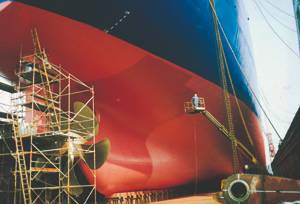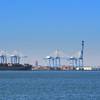Biofouling Center Stage
Legislation has been favorably reported out of the Senate Committee in Commerce, Science, and Transportation that would, if enacted, constitute the first official steps by the federal government to come to grips with biofouling of the hulls of ships. - by Dennis Bryant, Senior Counsel, Holland & Knight LLP
The Ballast Water Management Act of 2007 (S. 1578) would, among other things, require the U.S. Coast Guard to conduct a study of vessel-borne vectors (other than ballast water and sediment), specifically including vessel hulls, anchors, and equipment. A strategy would then have to be developed to address these vectors, including a recommendation for any new legislation that may be needed.
The United States Congress did not invent this issue.
Biofouling of ship’s hulls has been recognized as a problem throughout history. Boats and ships are regularly hauled out of the water for cleaning of the underwater surfaces. The practice of careening – defined as “to list a vessel so that a large part of her bottom is above the water, purposefully done to remove weed and marine growth” is of ancient origin. The original concerns of masters and owners was two-fold: (1) some marine growth, such as barnacles and kelp, would slow the ship’s speed through the water, thereby increasing costs of the voyage; and (2) other marine growth, such as the Teredo worm, would eat into the wooden hull and damage the watertight integrity of the ship.
Careening became impracticable as ships grew in size. An alternative was the sheathing of the underwater hull with copper, which was found to not only provide protection against the Teredo worm, but also to deter the growth of seaweed. After steel replaced wood as the material of choice for hulls, it was found that application of copper or tin based paint (organotin compounds) provided significant benefits for keeping the underwater surfaces relatively unpopulated by marine growth. Unfortunately, it was then discovered that at least some of these paints (particularly those containing tributyltin or TBT) could harm the marine environment by the leaching of that material into the water column. As a result, the International Convention on the Control of Harmful Anti-Fouling Systems on Ships, 2001 (the AFS Convention) has banned, the application of organotin compounds on hulls of ships engaged in international commerce.
Vectors for Aquatic Species Transfer
It was Charles Darwin, following the voyage of the HMS BEAGLE (1831-1836), who first posited that fouling of the ship’s hull could be a means for the inadvertent transport of marine organisms from one location to another. The ramifications of this concept were not fully appreciated or studied until well into the twentieth century. Some studies now indicate that, at least in certain locations, the introduction of non-indigenous aquatic species has occurred more frequently from biofouling than from discharge of ballast water.
Discharges of ballast water discharges tend to be highly visible and increasingly regulated. The International Convention for the Control and Management of Ships’ Ballast Water and Sediments, 2004 (Ballast Water Convention) will come into force when ratified by at least 30 States Party representing at least 35% of the world’s merchant shipping tonnage. Numerous nations and various sub-national governments have adopted unilateral measures to reduce the risk of introduction of potentially invasive aquatic species into their local marine ecosystem. The US Coast Guard, in its guidance on ballast water management, includes a brief mention of examining a ship’s hull, rudder, and propeller for evidence of excessive biofouling.
Only recently has the biofouling of hulls been studied as a potential vector for transfer of aquatic species. One of the better (and accessible) studies was conducted in 2006 by the US Coast Guard Research and Development Center. Entitled Preliminary Investigations of Biofouling of Ships’ Hulls: Non-Indigenous Species Investigations in the Columbia River, the USCG study found that fouling levels on ships’ hulls were highly variable and concluded that more data is needed to answer even basic questions regarding biofouling transfers.
New IMO Initiative
In his recent keynote address to the International Conference on Biofouling and Ballast Water Management, held in Goa, India on February 5-7, 2008, IMO Secretary-General Efthimios E. Mitropoulos, after discussing ballast water management, stated:
I now invite your attention to the other path of what some people call “invisible pollution”, caused partially by ships’ hull fouling. Introduction of biofouling is a risk posed by all vessel types, from small yachts, fishing vessels and large trading vessels engaged in international trade, through barges and mobile drilling rigs operating within ports and harbors or offshore at close distance from them. To effectively manage biofouling introductions, measures would need to address the diversity of vessel types and the large range of niche areas on these vessels and rigs. Evidence recently gathered by IMO Member States suggests that, in some regions, more than fifty per cent of marine introductions have occurred through the biofouling pathway and I wish to congratulate the organizers of this international, scientific gathering for their vision in facilitating timely discussions and exchange of information on this rather new subject.
As there are currently no international measures in place to address the risks of the introduction of invasive aquatic species through ships’ biofouling, I am pleased to inform you that IMO, in its well-established pro-active tradition and out of its own sensibility and concern for protection of the marine environment, has added a new high priority item spearheaded by Australia, New Zealand, the United Kingdom, Friends of the Earth International and the World Conservation Union to the work program of its Sub-Committee on Bulk Liquids and Gases to identify the best approach to address the issue. I am convinced that the outcome of your deliberations during the next three days will contribute to the work currently being done by the Sub-Committee, under the guidance of our Marine Environment Protection Committee, and facilitate the development of a realistic program to regulate ships’ biofouling issues through internationally-agreed measures. To that end, I would encourage the organizers of this important conference to submit to IMO the results of your deliberations.
Efforts in Hawaii
The State of Hawaii may have been the first government to officially initiate action to address the issue of biofouling of ships’ hulls when, in 2000, it designated the Hawaii Department of Land and Natural Resources as the lead state agency for preventing the introduction and carrying out the destruction of alien aquatic organisms through the regulation of ballast water discharges and hull fouling organisms. While the Department was authorized to adopt rules in accordance with this mandate and to enforce penalties for violation thereof, to date, little has been done other than public outreach and voluntary efforts due to a lack of funding. In 2003, though, the State of Hawaii Aquatic Invasive Species (AIS) Management Plan was adopted. Among other things, this plan advocates the implementation and funding of the Ballast Water and Hull Fouling Prevention Plan.
Biofouling Prevention Protocol in Australia
Australia has instituted a voluntary biofouling prevention protocol for vessels of less than 25 meters in length. The protocol recommends, among other things: (1) cleaning the vessel’s hull within one month prior to arrival in Australia; (2) applying antifouling paint within one year prior to arrival in Australia; or (3) arranging for the vessel to be hauled out and cleaned within one week of arrival in Australia. Plans call for the protocol to eventually become mandatory, but no date has been set for this change.
Information Gathering by California
Recently, California has been the most active governmental unit as regards the biofouling issue. In February 2007, in its report to the state legislature on its marine invasive species program, the State Lands Commission (SLC) discussed at length the biofouling issue and its role as a potential vector for introduction of non-indigenous species (NIS) into California waters. The report noted that the “most difficult challenge to evaluating NIS risk and for developing management recommendations was the limited amount of baseline information available on fouling and NIS across the types of vessels that regularly operate in California.” The report then recommended that the legislature authorize the SLC to develop and adopt regulations to minimize NIS release; to expand biological research to characterize the NIS risk posed by commercial chip fouling; and to collect information from vessels that call in California on those factors that influence fouling accumulation, such as vessel movement patterns and maintenance practices.
The California Legislature, without noticeable hesitation, provided the SLC with the sought-for authority in legislation adopted eight months later. The legislation, Assembly Bill No. 740, amends the California Marine Invasive Species Act, in pertinent part, to require owners and operators of large commercial vessels to provide hull condition information to the SLC as requested.
On January 28, 2008, the SLC issued form letters to shipping agents throughout the State of California advising of the new reporting requirement and asking the shipping agents to forward the information to vessel owners and operators which they represent. Attached to the form letter is a copy of AB 740 and a copy of the Hull Husbandry Reporting Form. The Hull Husbandry Reporting Form consists of four pages to be completed by the vessel owner or operator and three pages of instructions.
Summary and Recommendation
It is unclear at this point what use California will make of the hull husbandry information that it has begun to gather. It is also unclear what measures the United States and other port states may attempt to impose on ships to address potential biofouling of hulls. What is clear is that an issue first noted over 150 years ago has garnered the attention of the IMO and a variety of other jurisdictions. Ship owners and operators and their legal and trade representatives would be well-advised to engage on this issue in a timely and responsible manner. Prompt and thoughtful action at the international level may well forestall for hull biofouling the counter-productive hodgepodge of measures that the industry now faces with regard to ballast water management.













